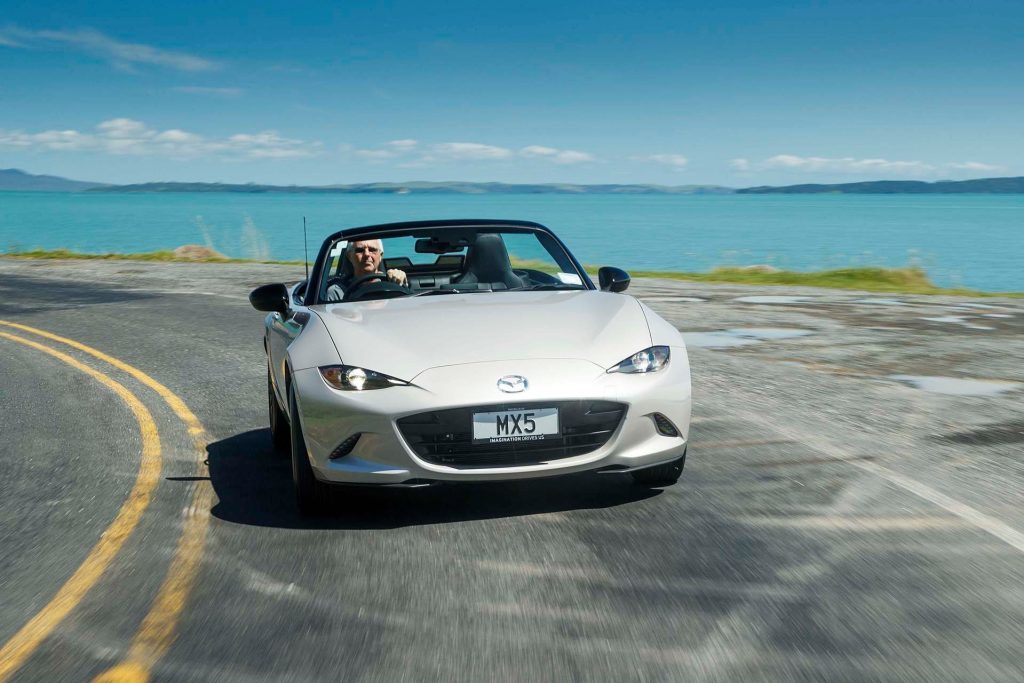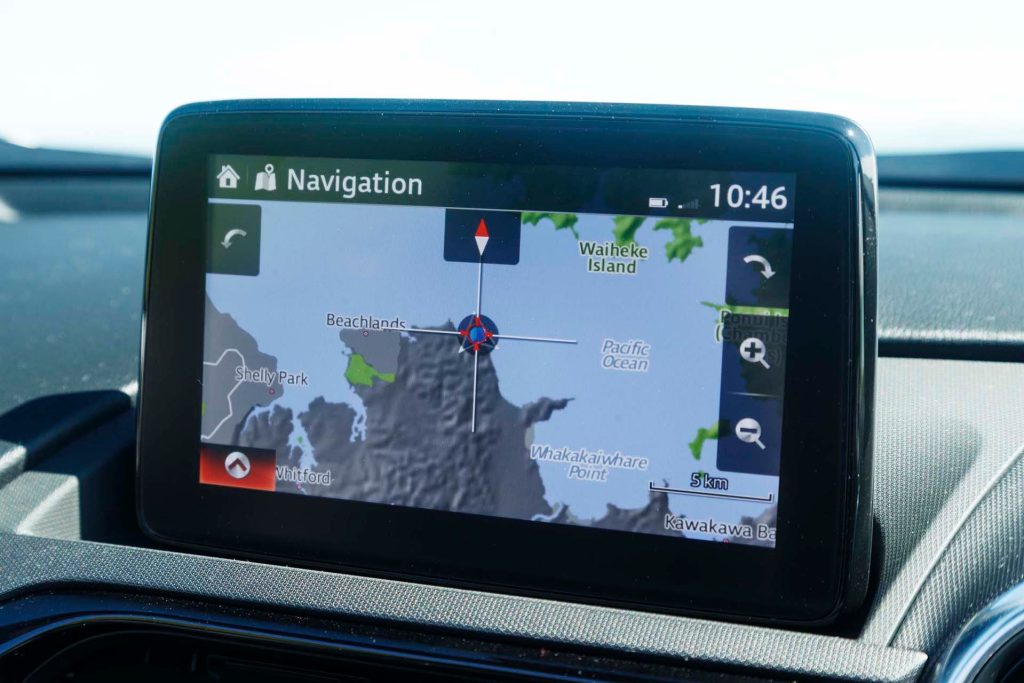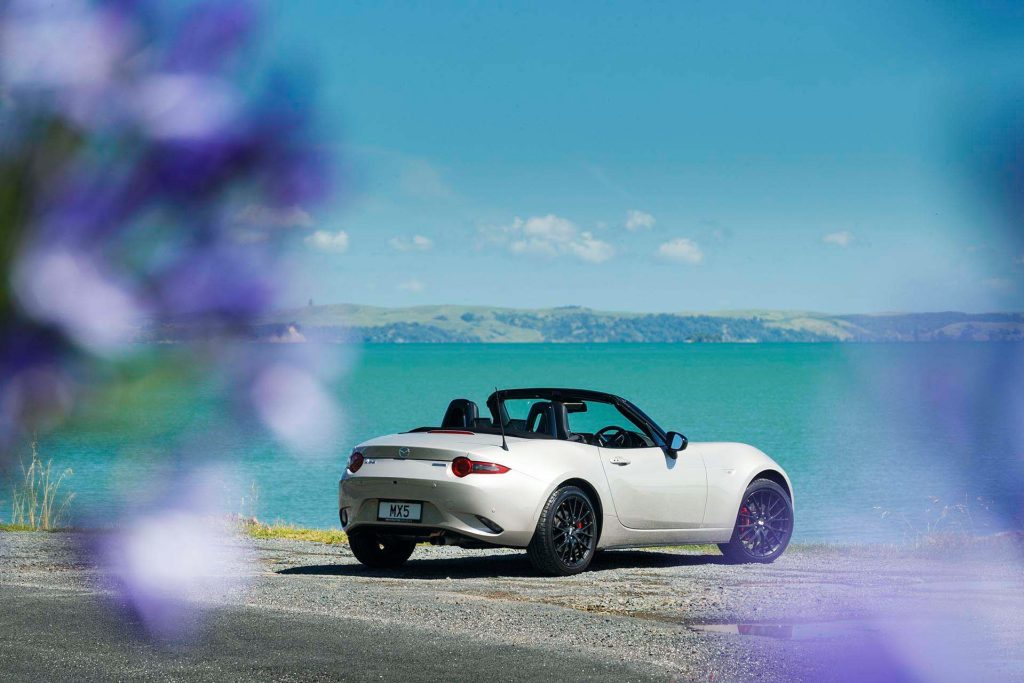2023 Mazda MX-5 GT review
Words: Peter Louisson | Photos: Tom Gasnier
Mazda engineers have fettled MX-5 underpinnings for even greater cornering capers. Is it a better thing or not?
The Mazda MX-5 is now well and truly a classic. It has been around since 1989, and the latest variant dubbed MX-5 Roadster GT is essentially much the same as it was all those years ago…with a few key differences. For it’s still rear-wheel drive, still has a small IL4 naturally aspirated engine, this one retains a six-speed manual transmission (an auto is available if you just must but only in the hardtop) and the roadster still has a soft top. There are still just the two seats, still not much in the way of oddments bins, and the boot remains something that will really only hold gear for two for a weekend (130L). Perfect then.

Naturally, the IL4 mill has come a long way, now at 2.0-litres and outputting 135kW and 205Nm, the latter at a reasonable 4000rpm but it’s on the case way before that. Because it’s a relative lightweight (1052kg) it still pulls handily in the 2000-3000rpm range, not bad for something without forced induction. It’s still a bit rowdy over chipseal, but you get that with lightweight convertibles.

What is this MX-5 GT model then?
The MX-5 Roadster GT ($58,290 plus ORC) is a running update before a new model arrives in 2024. That’s expected to be a reskin but with a hybrid powertrain for improved fuel efficiency. Meantime, this builds on the base Roadster by adding Bilstein Sports Dampers, Brembo front brakes, a suspension tower brace and BBS forged alloys. All of which should help with cornering and stopping duties. But wait, there’s something else as well; Mazda has updated its G-Vectoring Control Plus, and it now comes with Kinematic Posture Control or KPC.

Fancy name but essentially this is torque vectoring by brake. As Mazda says, it doesn’t add any extra weight because, like TV, it’s essentially another line of code in the ABS system. When forging on, a whiff of inside rear braking keeps the nose on line, suppresses roll, stabilises the car with an “antilift force” and improves road holding. The mild braking effect also works when accelerating through a corner, and KPC is being fitted to all MX-5s henceforth.

The changes to this model are perceptible, apart perhaps from the effect of the Brembos on stopping distances. Admittedly, we didn’t use our regular test strip but the best achieved of just under 35m disappointed slightly. On a better surface, we’d imagine results in the 33s are possible. That said, underfoot the stoppers feel resolute, as you’d expect of its uprated red calipers.

How does the Mazda MX-5 GT handle?
There are two clear upshots of the move to Bilstein performance dampers; firstly the body roll is much better contained so the tyres attack the road when cornering at a more useful angle. And secondly, the lovely ride and handling balance swings more in the favour of the latter. It’s not hard riding, the compliance still there when needed for bigger bumps but the secondary ride is less sophisticated. You notice that at slow speeds as the sharper bumps aren’t handled as well.

On the other hand, this now corners even better than before. What’s the point of this thing, the distaff asked, after dropping down into the passenger seat? It’s for people who like cars more than people I suggested, which didn’t go down well. She complained about the slow speed jiggle. I reminded her that back in the early 90s when she first drove an MX-5 she declared her undying admiration for it. You would remember that wouldn’t you, said she, muttering something about not remembering the kids’ birthdays.

Anyhow, I said it’s for purists who appreciate the car for what it is – a roadster that quickly transforms to an open-top and corners like its life depended on it. Yes, but what’s the point, she asked once again. Stupidly I mentioned that track day addicts would love it. Quick as a flash she replied that any environmentally aware person would consider circulating at high speed on track pointless and detrimental to the planet’s wellbeing. So the car she once loved (the only one) seems to have crashed and burned in her view. I was going to mention the five native trees Mazda plants with each MX-5 sold but I think the damage had already been done.

What is the Mazda MX-5 like to live with?
Others, like me, will understand what Mazda aimed for with the GT – more MX-5 enthrallment. Not only is it more level in the turns but they’ve made it turn in more quickly as well. That’s probably down to less roll, the installation of a strut tower brace, and the upgrade to lightweight forged BBS alloys; less unsprung weight means more immediacy and that’s for sure apparent at the wheel. Which, happily, remains alive with feedback, and its pure weighting. It’s such a joy to unwind sinuous roads in this; the front end responds equally in kind to a lift off as you go in, or a dab of brakes, or a shove on the gas, all tightening the line. There’s enough power in second to smoke the rears into some oversteery action too, the TC reining things in. On the right track, with TC off, this would be sensational fun, providing you don’t overdo the thrills. For those people who appreciate chassis balance and want a reasonably affordable track day car, the GT should be definitely on the list.

Naturally, it works well on fair weather days too, as the photos will attest. Stowing the hood is just so darn easy in this, and ditto restoring it.

How fast is the Mazda MX-5?
It’s been a while since we performance-tested one of these. Under ideal conditions, 0-100 is meant to take 6.3sec. We managed 6.5 without going for absolute gold – it requires a shift into third at 98, annoyingly – and an overtake in under 4.4sec is better than we’ve achieved before with any MX-5, in third gear alone.

And on that, this engine continues to sparkle, as does the fabulous manual transmission. Yes, the motor is still naturally aspirated but using revs between 2500 and 3000 in town makes for hasty progress. Anything north of 3500rpm and it really starts to fire while from 4500 to just over 7000rpm is where the real magic hangs out. It’s great on gas too, our average of 7.3L/100km included performance testing (7.6 is the WLTP figure). At 100 it’s turning over 2500rpm in sixth but that feels and sounds completely effortless, with fuel use in the fours.

The manual box is just like it was from the outset; peerless. Even rushed it is fully cooperative. It’s one of those manuals that’s so well lubed you sometimes find yourself changing gear for the sheer mechanical pleasure of it. Skip shifting is more than possible with this too, if you’re feeling lazy.

Safety items include adaptive LED headlights, AEB, BSM and rear cross traffic alert. Lane departure warning we turned off. There’s no digital speedo – it needs one – but traffic sign recognition comes in real handy. The Bose head unit with nine speakers and subwoofer is banging fun too.

So in essence, the MX-5 has still got it, like the original, along with a five-year warranty and three years of free servicing. It’s also fee neutral, a rarity among driver’s cars. It remains amongst the purest of drives you’ll find, regardless of cost.
| Model | Mazda MX-5 GT |
| Price | $58,290 |
| Clean Car Discount | Neutral $0 |
| Engine | 1998cc, IL4,DI |
| Power/Torque | 135kW/205Nm |
| Drivetrain | 6-speed manual, RWD |
| Fuel Use | 7.6L/100km |
| C02 Output | 176g/km |
| 0-100km/h | 6.53sec |
| 80-120km/h | 4.39sec (125.6m) |
| 100-0km/h | 34.79m |
| Stability systems | ABS, ESP, TV |
| Safety | AEB, BSM, LDW, RCTA, AHB |
| Luggage Capacity | 130L |
| Tow rating | Not rated to tow |
| Service intervals | 12 months/20,000km |
| Scheduled servicing | 3 years/100,000km |
| Warranty | 5 years/unlimited km |
| ANCAP rating | 5 stars (2016) |
| Weight | 1052kg (claimed) |





